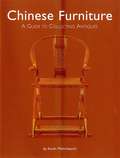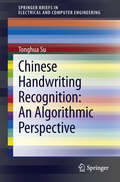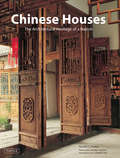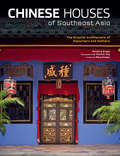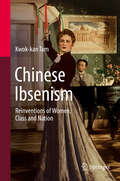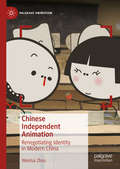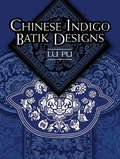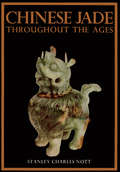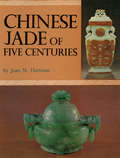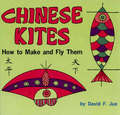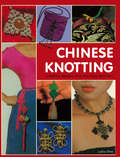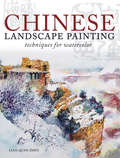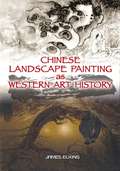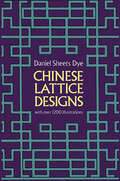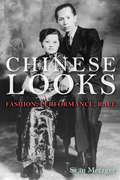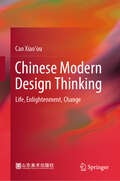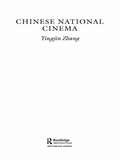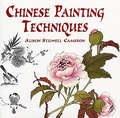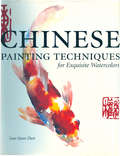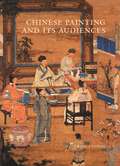- Table View
- List View
Chinese Furniture
by A. Chester Ong Karen MazurkewichThe international market for antique Chinese furniture is booming, and masterpieces from the Ming and Qing dynasties are now worth hundreds of thousands of dollars. Chinese Furniture is a survey of these collectibles—from the very best hardwood pieces featured to standard softwood specimens still available on the Asian market. The book presents an overview of carving styles, wood types, regional variations, class distinctions and restoration techniques.With this renewed interest in antique furniture, a forgery market has emerged. Thousands of factories in southern China are churning out brand new or refurbished furniture and passing them off as antiques. Chinese Furniture unearths these forgeries and serves as an indispensable reference guide to collectors.
Chinese Furniture
by A. Chester Ong Karen MazurkewichThe international market for antique Chinese furniture is booming, and masterpieces from the Ming and Qing dynasties are now worth hundreds of thousands of dollars. Chinese Furniture is a survey of these collectibles—from the very best hardwood pieces featured to standard softwood specimens still available on the Asian market. The book presents an overview of carving styles, wood types, regional variations, class distinctions and restoration techniques.With this renewed interest in antique furniture, a forgery market has emerged. Thousands of factories in southern China are churning out brand new or refurbished furniture and passing them off as antiques. Chinese Furniture unearths these forgeries and serves as an indispensable reference guide to collectors.
Chinese Furniture
by A. Chester Ong Karen MazurkewichThe international market for antique Chinese furniture is booming, and masterpieces from the Ming and Qing dynasties are now worth hundreds of thousands of dollars. Chinese Furniture is a survey of these collectibles—from the very best hardwood pieces featured to standard softwood specimens still available on the Asian market. The book presents an overview of carving styles, wood types, regional variations, class distinctions and restoration techniques.With this renewed interest in antique furniture, a forgery market has emerged. Thousands of factories in southern China are churning out brand new or refurbished furniture and passing them off as antiques. Chinese Furniture unearths these forgeries and serves as an indispensable reference guide to collectors.
Chinese Handwriting Recognition: An Algorithmic Perspective (SpringerBriefs in Electrical and Computer Engineering)
by Tonghua SuDesigning machines that can read handwriting like human beings has been an ambitious goal for more than half a century, driving talented researchers to explore diverse approaches. Obstacles have often been encountered that at first appeared insurmountable but were indeed overcome before long. Yet some open issues remain to be solved. As an indispensable branch, Chinese handwriting recognition has been termed as one of the most difficult Pattern Recognition tasks. Chinese handwriting recognition poses its own unique challenges, such as huge variations in strokes, diversity of writing styles, and a large set of confusable categories. With ever-increasing training data, researchers have pursued elaborate algorithms to discern characters from different categories and compensate for the sample variations within the same category. As a result, Chinese handwriting recognition has evolved substantially and amazing achievements can be seen. This book introduces integral algorithms used in Chinese handwriting recognition and the applications of Chinese handwriting recogniers. The first part of the book covers both widespread canonical algorithms to a reliable recognizer and newly developed scalable methods in Chinese handwriting recognition. The recognition of Chinese handwritten text is presented systematically, including instructive guidelines for collecting samples, novel recognition paradigms, distributed discriminative learning of appearance models and distributed estimation of contextual models for large categories, in addition to celebrated methods, e.g. Gradient features, MQDF and HMMs. In the second part of this book, endeavors are made to create a friendlier human-machine interface through application of Chinese handwriting recognition. Four scenarios are exemplified: grid-assisted input, shortest moving input, handwritten micro-blog, and instant handwriting messenger. All the while, the book moves from basic to more complex approaches, also providing a list for further reading with literature comments.
Chinese Houses
by Jonathan Spence A. Chester Ong Ronald G. KnappWinner of ForeWord Magazine's Architecture "Book of the Year" Award!Exquisite examples of traditional dwellings are scattered throughout modern-day China. Chinese Houses focuses on 20 well-preserved traditional homes, presenting examples from a range of rural and metropolitan areas throughout China.The photographs of each are accompanied by extensive background information and historical content. An introductory essay examines the different types of Chinese homes and provides an overview of the rich regional variety of Chinese dwelling forms. It also provides insights into little-known design concepts that emphasize the flexibility, adaptability, and versatility of traditional building forms and the work of traditional craftsmen.Richly illustrated with photographs, woodblock prints, historic images, and line drawings, Chinese Houses portrays an architectural tradition of amazing range and resilience.
Chinese Houses
by Jonathan Spence A. Chester Ong Ronald G. KnappWinner of ForeWord Magazine's Architecture "Book of the Year" Award!Exquisite examples of traditional dwellings are scattered throughout modern-day China. Chinese Houses focuses on 20 well-preserved traditional homes, presenting examples from a range of rural and metropolitan areas throughout China.The photographs of each are accompanied by extensive background information and historical content. An introductory essay examines the different types of Chinese homes and provides an overview of the rich regional variety of Chinese dwelling forms. It also provides insights into little-known design concepts that emphasize the flexibility, adaptability, and versatility of traditional building forms and the work of traditional craftsmen.Richly illustrated with photographs, woodblock prints, historic images, and line drawings, Chinese Houses portrays an architectural tradition of amazing range and resilience.
Chinese Houses of Southeast Asia
by A. Chester Ong Ronald G. Knapp Wang GungwuThe multiple Chinese migrations from southeastern China to Southeast Asia have had important implications for both regions. In Southeast Asia this influence can be seen in the architecturally eclectic homes these migrants and their descendants built as they became successful; homes that combined Chinese, European and local influences, especially during the nineteenth and early twentieth centuries. Chinese Houses of Southeast Asia strives not only to be an informative but also an authoritative book on the subject of hybrid architecture. It's filled with stunning color photographs and essays on nearly thirty well-preserved homes.
Chinese Ibsenism: Reinventions of Women, Class and Nation
by Kwok-kan TamThis book is a study of the relation between theatre art and ideology in the Chinese experimentations with new selfhood as a result of Ibsen’s impact. It also explores Ibsenian notions of self, women and gender in China and provides an illuminating study of Chinese theatre as a public sphere in the dissemination of radical ideas. Ibsen is the major source of modern Chinese selfhood which carries notions of personal and social liberation and has exerted great impacts on Chinese revolutions since the beginning of the twentieth century. Ibsen’s idea of the self as an individual has led to various experimentations in theatre, film and fiction to project new notions of selfhood, in particular women’s selfhood, throughout the history of modern China. Even today, China is experimenting with Ibsen’s notions of gender, power, individualism and self.Kwok-kan Tam is Chair Professor of English and Dean of Humanities and Social Science at the Hang Seng University of Hong Kong. He was Head (2012-18) and is currently a member of the International Ibsen Committee, University of Oslo. He is a Foundation Fellow of the Hong Kong Academy of the Humanities. He has held teaching, research and administrative positions in various institutions, including the East-West Center, the Chinese University of Hong Kong and the Open University of Hong Kong. He has published numerous books and articles on Ibsen, Gao Xingjian, modern drama, Chinese film, postcolonial literature, and world Englishes. His recent books include Ibsen, Power and the Self: Postsocialist Experimentations in Stage Performance and Film (2019), The Englishized Subject: Postcolonial Writings in Hong Kong, Singapore and Malaysia (2019), and a co-edited volume Fate and Prognostication in the Chinese Literary Imagination (2019).
Chinese Independent Animation: Renegotiating Identity in Modern China (Palgrave Animation)
by Wenhai ZhouThis study of ‘independent’ animation opens up a quietly subversive and vibrant dimension of contemporary Chinese culture which, hitherto, has not received as much attention as dissident art or political activism. Scholarly interest in Chinese animation has increased over the last decade, with attention paid to the conventional media circle of production, distribution and consumption. The ‘independent’ sector has been largely ignored however, until now. By focusing on distinctive independent artists like Pisan and Lei Lei, and situating their work within the present day media ecology, the author examines the relationship between the genre and the sociocultural transformation of contemporary China. Animation, the author argues, has a special significance, as the nature of the animation text is itself multilayered and given to multiple interpretations and avenues of engagement. Through an examination of the affordances of this ‘independent’ media entity, the author explores how this multifaceted cultural form reveals ambiguities that parallel contradictions in art and society. In so doing, independent animation provides a convenient ‘mirror’ for examining how recent social upheavals have been negotiated, and how certain practitioners have found effective ways for discussing the post-Socialist reality within the current political configuration.
Chinese Indigo Batik Designs (Dover Pictorial Archive)
by Lu PuRich in tradition and history, the art of batik has been a deeply integrated facet of Chinese folk art for over 2,000 years. Using molten beeswax, skilled artisans paint patterns onto white cloth, which is then dipped into indigo dye. When the wax is removed with boiling water, unique designs of great harmony and beauty remain. The themes depicted in batik decoration have a strong native flavor, and are distinctive of the Chinese provinces and districts where they were created. In Huangping, mountains, trees, and birds are represented. In the Miao district, the concentration is on flowers and butterflies, while in the Yunnan Province, designs of peacocks, monkeys, and elephants abound. In this stunning pictorial archive, more than 110 authentic designs have been carefully reproduced from a rare, early collection of batik art. Collected from the remote areas of China's southwestern provinces, each decorative pattern is rich in beauty and meaning. This royalty-free volume will be an invaluable resource for artists, designers, craftspeople, and any lover of traditional Chinese folk art.
Chinese Jade Throughout the Ages
by Stanley Charles NottFirst published in 1936 and since then a collector's item of increasing rarity, Chinese Jade Throughout the Ages comprises a review of the characteristics, decorations, folklore, and symbolism of this esteemed mineral that has always held a proud place among gems of the world. The book presents a full descriptive account of the significance and meaning of the carvings produced in this prize stone by Chinese craftsmen from the earliest times, through the Chou and succeeding dynasties, down to the twentieth century.
Chinese Jade of Five Centuries
by Joan M. HartmanChinese Jade of Five Centuries was originally published in print form by Tuttle Publishing in 1969.In Chinese Jade of Five Centuries, Mrs Hartman provides an encompassing look at one of the minor arts which must be considered vital to a judgement of artistic achievements of any civilization.Magnificently illustrated with 45 black and white photographs and 10 color plates, the book displays many museum examples which have not been previously published for general readership. Written for the layman, the text should satisfy the more discerning and knowledgeable reader as well, particularly for it's information on the quality and location of jade rough, on dating, and techniques of carving.
Chinese Jade of Five Centuries
by Joan M. HartmanChinese Jade of Five Centuries was originally published in print form by Tuttle Publishing in 1969.In Chinese Jade of Five Centuries, Mrs Hartman provides an encompassing look at one of the minor arts which must be considered vital to a judgement of artistic achievements of any civilization.Magnificently illustrated with 45 black and white photographs and 10 color plates, the book displays many museum examples which have not been previously published for general readership. Written for the layman, the text should satisfy the more discerning and knowledgeable reader as well, particularly for it's information on the quality and location of jade rough, on dating, and techniques of carving.
Chinese Jade of Five Centuries
by Joan M. HartmanChinese Jade of Five Centuries was originally published in print form by Tuttle Publishing in 1969.In Chinese Jade of Five Centuries, Mrs Hartman provides an encompassing look at one of the minor arts which must be considered vital to a judgement of artistic achievements of any civilization.Magnificently illustrated with 45 black and white photographs and 10 color plates, the book displays many museum examples which have not been previously published for general readership. Written for the layman, the text should satisfy the more discerning and knowledgeable reader as well, particularly for it's information on the quality and location of jade rough, on dating, and techniques of carving.
Chinese Kites
by David JueBeside an avenue near his Palo Alto home, Mr. Jue noticed a fine clump of greenbamboo destined to be uprooted in a street-widening project. In the culture of Mr. Jue's boyhood, the bamboo is a pervasive symbol, a gift from nature of grace and beauty-and, to the eminently practical Chinese, a uniquely useful item. This gift of nature was meant to be either cherished or harvested for use. He proceeded to rescue the bamboo from the indignity of the bulldozer and the waste of the trash heap. What more natural than that the feel of the bamboo in his hands should recall pleasant memories from his boyhood-and that kite-making should be one of them? Mr. Jue had found a new and consuming interest in life. He began making kites as he remembered them of old, eventually inventing new designs and adapting the old techniques to the materials at hand in his community. A soaring kite, beautifully formed and painted, with colorful streaming tails, is a striking sight in this increasingly mechanical and prosaic age. The children of the neighborhood flocked about whenever Mr. Jue lofted his kites and soon joined in the fun. Inevitably, they invaded his workshop and joined in the fun of making and painting the kites, as well.Mr. Jue's personal diversion had gained a new dimension. Teaching children andsharing their unreserved delight at a first launching was mote fun than merely making kites for his own amusement. And the sudden upsurge of interest in an exotic handicraft and constructive sport soon leaped the boundaries of Mr. Jue's neighborhood. Feature articles appeared in the newspapers of Palo Alto, Sanjose, and San Francisco. Schools and department stores invited Mr. Jue to give demonstrations. Hundreds of inquiries came by mail and telephone. The spreading interest in Chinese kite-making has encouraged Mr. Jue in his effort to bring an ancient and rewarding folk-art to the youth of his adopted land.
Chinese Knotting
by Lydia ChenKnotting, "the joining of two cords," is an old and revered art form in China and an integral part of Chinese life. Since ancient times, Chinese knots have been used for a variety of practical and decorative purposes: to record events, aid in fishing and hunting, wrap and tie items, embellish personal attire, jewelry, fashion, ornament other works of art, and communicate. The intricate knot work and magnificent color combinations not only lent elegance to everyday objects, or a touch of gaiety and enchantment, but were an aesthetic expression of Chinese folk symbolism, expressing wishes for good fortune and wealth or the joys of love and marriage. In craft book Chinese Knotting, author Lydia Chen first traces the origins, history, and symbolism of this fascinating craft, before taking the reader through the fundamental elements necessary for tying Chinese decorative knots-the materials, implements, and main processes.Step-by-step instructions are then given for the 11 basic knots, which provide the building blocks for the 14 compound knots-combinations and variations of the simple knots-that follow in the next section. The final section presents 41 knotting projects of varying difficulty. Detailed instructions, clear diagrams, and color photographs, combined with an exciting assortment of creative applications will help readers discover the relaxation, artistic satisfaction, and beautifully personalized ornamentation that Chinese Knotting can offer.
Chinese Landscape Painting Techniques for Watercolor
by Lian Quan ZhenMinimum stroke - maximum effectLearn how to make each brushstroke count when painting classically beautiful landscapes using a combination of traditional and modern watercolor techniques.Master artist and teacher Lian Quan Zhen shows how to blend Eastern and Western art theories, materials and techniques to create landscapes with graceful simplicity.Chinese Landscape Painting Techniques for Watercolor includes 27 start-to-finish demonstrations, which show how to capture the spirit and mood of the landscape in all types of weather and in all four seasons. It also features a wide variety of landscape subjects from America and around the world.
Chinese Landscape Painting as Western Art History
by James ElkinsThis is a provocative essay of reflections on traditional mainstream scholarship on Chinese art as done by towering figures in the field such as James Cahill and Wen Fong. James Elkins offers an engaging and accessible survey of his personal journey encountering and interpreting Chinese art through Western scholars' writings. He argues that the search for optimal comparisons is itself a modern, Western interest, and that art history as a discipline is inherently Western in several identifiable senses. Although he concentrates on art history in this book, and on Chinese painting in particular, these issues bear implications for Sinology in general, and for wider questions about humanistic inquiry and historical writing.
Chinese Lattice Designs
by Daniel Sheets DyeChinese craft design excelled in the manipulation of geometric space and reached its highest point in the design of window lattices on Chinese houses. Long recognized as an important folk art, window lattices have been generally neglected as an art form and this book is the first work on the subject since the 17th century. Fortunately, it is also the definitive work on the subject, and though no book can present a complete coverage of Chinese lattice, this book is a great classic study and an incredibly rich source of design for Westerners.More than 1200 designs are shown here, arranged in a clear system of classification that includes 22 areas of related design -- borders, brackets, tail pieces, and so on. The lattices are classified according to one basic figure or concept, and the hundreds of beautiful design variations fall into only 26 categories: parallelogram, octagon or octagon square, hexagon, single focus frames, double focus frames, triple focus frames, quintuple focus frames, no focus frames, wedge-lock, presentation, out-lock, in-out bound, the Han line, parallel waves, opposed waves, recurving wave, loop-continued, like swastikas (a Buddhist symbol), unlike swastikas, central Ju I, allover Ju I, S-scroll, U-scroll, rustic ice-ray, symmetrical ice-ray, and square and round. Each category is introduced in sections at the front. In addition, there is usually a short description for each design and every design is designated by name, location, and approximate date of construction.Professor Dye spent over 21 years studying and copying lattices all over China, and because of the ravages of time and changing cultural values, this collection can probably never be duplicated. Balanced, intricate, sometimes asymmetrical, usually harmonious, these lattice designs present a wealth of material for the Western commercial artist, textile designer, pattern-maker, and craftsman. Reflecting their Chinese heritage, these designs are universal and can be used almost anywhere.
Chinese Looks
by Sean MetzgerFrom yellow-face performance in the 19th century to Jackie Chan in the 21st, Chinese Looks examines articles of clothing and modes of adornment as a window on how American views of China have changed in the past 150 years. Sean Metzger provides a cultural history of three iconic objects in theatrical and cinematic performance: the queue, or man's hair braid; the woman's suit known as the qipao; and the Mao suit. Each object emerges at a pivotal moment in US-China relations, indexing shifts in the balance of power between the two nations. Metzger shows how aesthetics, gender, politics, economics, and race are interwoven and argues that close examination of particular forms of dress can help us think anew about gender and modernity.
Chinese Modern Design Thinking: Life, Enlightenment, Change
by Cao Xiao'ouThis book studies the development of modern and contemporary design art in China since 1978. Starting with the design enlightenment, and closely following the evolution of the visual and material forms in three levels of “individual”, “group”, and “country” since the reform and opening up, the book comprehensively and meticulously describes and analyzes the social particularity of the changes of Chinese design art in this period and makes corresponding evaluations on its “success” and “failure”. The author believes that Chinese modern design thinking has arisen from the problems displayed in the phenomena and events of Chinese modern design. Therefore, with nine chapters organized in chronological order and unfolded layer by layer by focusing on the relevant topics of “design thinking”, the book has sorted out the academic contentions, important events, phenomena, details of Chinese design in this period by placing design in the background of great history, and has searched, discovered, and summarized the key problems of Chinese design in each stage, and analyzed the causes and consequences, and has specially studied on the gains and losses of important phenomena and theoretical problems and correspondingly made theoretical comments. Therefore, it is a book comprehensively presenting the overall look of the development of Chinese modern design “thinking” history.This book has a grand structure and detailed content. The author and her research objects always coexist in the same context, and the writing style is fresh, the argument is reasonable, and the pictures and texts complement each other, so the book has both academic depth and readability.
Chinese National Cinema (National Cinemas #20)
by Yingjin ZhangThis introduction to Chinese national cinema covers three 'Chinas': mainland China, Hong Kong and Taiwan. Historical and comparative perspectives bring out the parallel developments in these three Chinas, while critical analysis explores thematic and stylistic changes over time. As well as exploring artistic achievements and ideological debates, Yingjin Zhang examines how - despite the pressures placed on the industry from state control and rigid censorship - Chinese national cinema remains incapable of projecting a single unified picture, but rather portrays many different Chinas.
Chinese Painting Techniques (Dover Art Instruction)
by Alison Stilwell CameronOver thousands of years, the art of Chinese paintings has been refined into an exquisitely developed system of visual representation. But until the publication of this volume, there was no single source that bridged the gap between the philosophical and imitative methods of instruction. Alison Stilwell Cameron, daughter of famed World War II General Joseph Stilwell, spent her early childhood and teenage years in China where she studied under two renowned Chinese artists -- Yu Fei-am and Prince P'u Ju of the imperial family. Having achieved wide recognition for her mastery of Chinese painting, she distilled her knowledge in this book, providing step-by-step instruction for those with no art training at all.Starting with an explanation of the physical tools of the art, she describes the basic strokes and the creation of Chinese characters before moving on to demonstrate the use of these strokes to represent trees, flowers, rocks, boats, insects, birds, and other subjects. These elements are then combined to produce finished Chinese paintings, "the kind of pleasing and satisfying pictures that thousands of amateurs have been producing in China for centuries."Enhanced with hundreds of illustrations, including 36 in full color, this handsome volume also contains a chapter on the mounting process, a valuable bibliography, and an index. It is an invaluable guide to an art, which -- once mastered -- will not only delight viewing audiences but will bring satisfaction throughout the artist's lifetime.
Chinese Painting Techniques for Exquisite Watercolors: For Exquisite Watercolours
by Lian Quan ZhenCapture the beauty and vitality of Chinese painting in your watercolors!Using a few brushes, some rice paper and a small number of inks and paints, you can explore new realms of artistic expression in your watercolors. Author and artist Lian Quan Zhen shows you how, providing you with the clear, practical instruction you need to master every element of this intriguing style - from holding a bamboo brush to applying Chinese composition techniques.Zhen makes learning easy with step-by-step instructions that enable you to apply brushstrokes with strength and confidence - a skill that will carry over into your everyday watercolor work. And you'll find inspiration in Zhen's own works of art - ranging from egrets in flight to gracefully swimming koi - as you discover the best techniques of the East and West. He'll show you that the beauty of fine art crosses every border and that your artistic journey has no limits.
Chinese Painting and Its Audiences (The A. W. Mellon Lectures in the Fine Arts #61)
by Craig ClunasA history of the reception of Chinese painting from the sixteenth century to the presentWhat is Chinese painting? When did it begin? And what are the different associations of this term in China and the West? In Chinese Painting and Its Audiences, which is based on the A. W. Mellon Lectures in the Fine Arts given at the National Gallery of Art, leading art historian Craig Clunas draws from a wealth of artistic masterpieces and lesser-known pictures, some of them discussed here in English for the first time, to show how Chinese painting has been understood by a range of audiences over five centuries, from the Ming Dynasty to today. Chinese Painting and Its Audiences demonstrates that viewers in China and beyond have irrevocably shaped this great artistic tradition.Arguing that audiences within China were crucially important to the evolution of Chinese painting, Clunas considers how Chinese artists have imagined the reception of their own work. By examining paintings that depict people looking at paintings, he introduces readers to ideal types of viewers: the scholar, the gentleman, the merchant, the nation, and the people. In discussing the changing audiences for Chinese art, Clunas emphasizes that the diversity and quantity of images in Chinese culture make it impossible to generalize definitively about what constitutes Chinese painting.Exploring the complex relationships between works of art and those who look at them, Chinese Painting and Its Audiences sheds new light on how the concept of Chinese painting has been formed and reformed over hundreds of years.Published in association with the Center for Advanced Study in the Visual Arts, National Gallery of Art, Washington, DCPlease note: All images in this ebook are presented in black and white and have been reduced in size.
